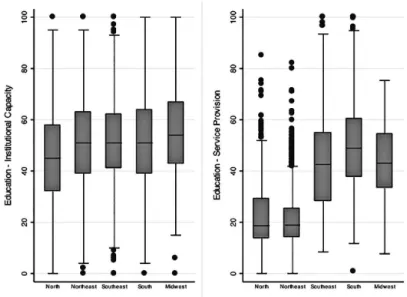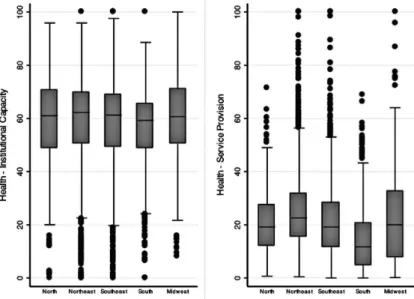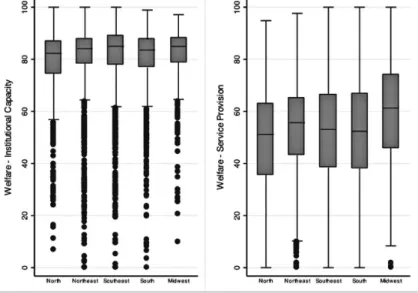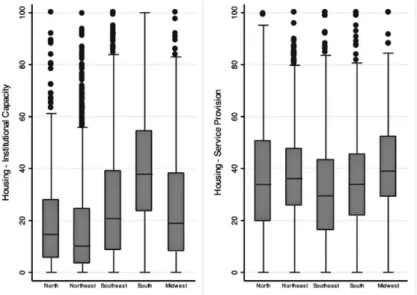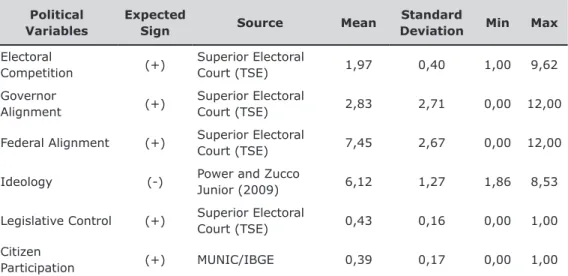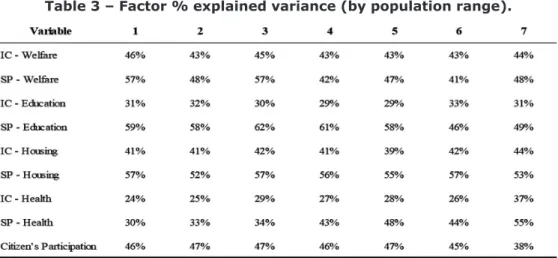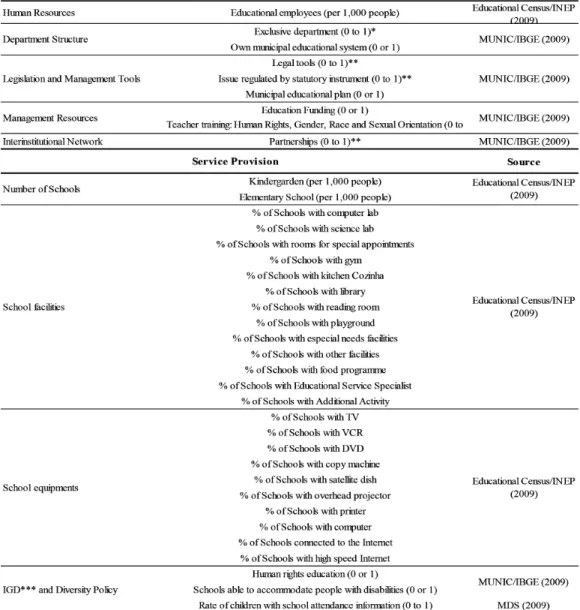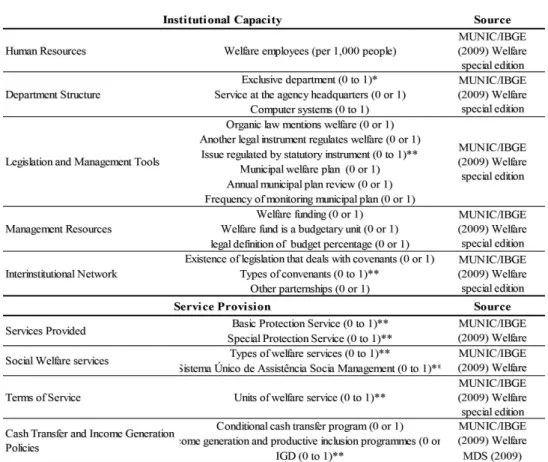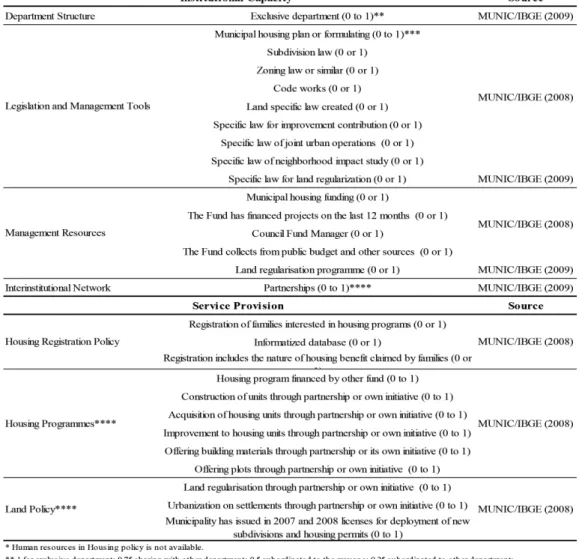E
lEctions and local govErnmEntpErformancE in
B
razilPedro Luiz Costa Cavalcante*
Abstract
T
he 1988 federal Constitution introduced a complex and innovative institutional arrangement that not only reestablished political rights and democratic procedures, but also reinforced decentralization as a fundamental guideline for policy implementation in Brazil. As a result, municipalities have become pivotal actors in the policymaking process. Scholars of Latin American politics have given much emphasis to the causes and determinants of decentralization, but not much has been done toward a more general understanding of how this increased decentralization has afected policymaker behavior and policy outcomes. This paper aims to do exactly that. Speciically, it investigates how institutional arrangements and electoral competition afect local government performance. The theoretical basis is the electoral democratic theory that broadly highlights elections as instruments of citizen control in retrospective and prospective voting approaches. The research employs a large-N cross sub-national analysis based on a dataset of electoral, partisan, socioeconomic and public inancial information collected from over 5500 municipalities. Local governments’ performance, our dependent variables, are synthetic indicators formulated from 2009 nationwide surveys on public education, health, housing and welfare services. The OLS regression results conirm the hypothesis that politics variables do matter in how politicians make decisions and implement policy under the new Brazilian democratic Era. The empirical evidences suggest that electoral competition does not present a direct efect on government performance, however, ideology and citizen participation do. Therefore, this paper helps to expand our understanding of a political system’s impact on public policy outputs, which is extremely important not only for academic purpose but also to support policymakers’ decisions.Keywords: Elections. Public policy. Decentralization. Local government performance. Brazil.
E
lEiçõEs E dEsEmpEnho do govErnolocal no
B
rasilResumo
A
Constituição Federal de 1988 introduziu um arranjo institucional complexo e inovador que não só restabeleceu direitos políticos e procedimentos democráticos, mas também reforçou a descentralização como uma diretriz fundamental às políticas públicas no Brasil. Como resultado, os municípios se tornaram atores fundamentais no processo de formulação e implementação de políticas públicas. Os estudiosos da política latino-americana deram muita ênfase às causas e determinantes da descentralização, mas pouco avançaram em entender como o aumento da descentralização tem afetado o comportamento dos formuladores e os resultados das políticas, em termos mais gerais. Este artigo pretende fazer exatamente isso. Mais especiicamente, investiga-se como arranjos institucionais e competição eleitoral afetam o desempenho do governo local. A base teórica é a teoria democrática eleitoral que destaca os instrumentos de controle do cidadão em abordagens de votação retrospectiva e prospectiva. A pesquisa emprega a análise transversal(cross-section) baseada em um conjunto de dados de informações eleitorais, partidárias, socioeconômicas e de inanças públicas coletadas de mais de 5500 municípios. Os desempenhos do governo local, nossas variáveis dependentes, são representados por indicadores sintéticos formulados a partir de pesquisas oiciais nacionais de sobre educação pública, saúde, habitação e serviços de assistência social. Os resultados da regressão OLS conirmam a hipótese de que a política importa no processo de tomada de decisões e na implementação de políticas na atual Era democrática brasileira. As evidências empíricas sugerem que a competição eleitoral não apresenta efeito direto sobre o desempenho do governo, no entanto, ideologia e participação dos cidadãos sim. Portanto, este artigo ajuda a expandir nossa compreensão do impacto do sistema político sobre os resultados das políticas públicas, o que é importante não apenas para ins acadêmicos, mas também para apoiar o processo decisório nos governos.
Palavras-chave: Eleições. Políticas públicas. Descentralização. Desempenho do governo local. Brasil.
Introduction
T
he 1988 federal Constitution introduced a complex and innovative institutional arrangement that not only reestablished political rights and democratic procedures, but also reinforced decentralization and citizen participation as fundamental guidelines for policy implementation in Brazil. As a result, municipalities have become pivotal actors in the policymaking process.Scholars of Latin American politics have given much emphasis to the causes and determinants of decentralization, but not much has been done toward understanding how politics afects policymaker behavior and policy outputs under this new democratic setting. This paper aims to do exactly that. Speciically, it investigates how a political system’s aspects, such as electoral competition and citizen participation, among others, impact local government performance. This issue became even more relevant in comparative policy analysis due to the fact that policy results in Brazil are extremely diverse. Put diferently, despite the advances provided by the new legal framework and the governance improvements after two decades, inequality is the word that best deines policy implementation in this country.
It is noteworthy that the Brazilian cities are also heterogeneous in others aspects, such as geographic, social and economic dimensions. However, are these structural factors the only reasons for the variance in policy outputs? This paper’s main argument disagrees. The hypothesis to be tested is that the political system’s dynamics at a sub-national level under the new democratic Era impact governmental performance. The basis is that those who make decisions on public policy, e.g. elected oicials and parties, respond to incentives and constraints, as electoral rules or the level of political participation (CLEARY, 2007; IMMERGUT, 2006; PUTNAM, 1999). In other words, the understanding of a policy’s determinants comes from the choices’ intentionality. Policy outputs are consequences of the decision making process in which stakeholders are afected not only by structural factors, but also by democratic political dynamics.
The inquiry employs a large-N cross sub-national quantitative analysis based on electoral, partisan, socioeconomic and geographic data collected from almost every Brazilian municipality. Synthetic indicators, formulated from 2009 nationwide surveys on public education, health, housing and welfare policies, are our dependent variables – local government performance.
Democratization and institutional
changes in Brazil
After twenty-one years of military regime, in the mid 80’s Brazil began to experience a transition to democracy. Although some civil and political rights, such as the freedom of association, right to assemble and to vote were restored in the beginning of this decade, the country was governed by a politician not elected by the people’s vote until 1990. The federal Constitution of 1988 came to intensify the democratization process, reestablishing social rights and new institutional arrangements for public policies.
There is consensus that the Brazilian welfare system before the Constitution was essentially corporatist, political and inancially centralized in the federal government (DRAIBE, 1990; MEDEIROS, 2001; IPEA, 2009). Social policies were very restricted and fragmented. In other words, the targeted population was restricted, mostly, to urban workers and their beneits, and services were provided by a dispersed range of organizations.
During Constitutional debates, nonetheless, pressures for a proactive state in the social area and for a fair division of responsibilities and revenues among government levels were evident. Social movements and interest groups lobbied congressmen for the following demands: inclusion of population sectors not covered by welfare or other social policy; permanent and transparent mechanisms of policy inancing; equal rights between urban and rural workers; citizens’ participation in the policymaking processes and; above all, iscal and administrative decentralization. Consequently, the decisions changed for good public policy and states’ responsibilities in Brazil. By law, health, education, housing and welfare programs became compulsory governmental with citizen’s rights to all in need.
Universalistic principles came along with a remaining corporativist basis (ESPING-ANDERSEN, 1991; CARVALHO, 2002) in the new social policy framework that included mandatory governmental expenditures in public health and education, welfare beneits without previous contributions and labor rights, such as a national minimum wage, public pension system and equivalent treatment for rural workers. Therefore, the formal assumptions were formulated to accomplish widespread and equal access to public policy, in order to move towards a universalistic model of a welfare state.
Regarding policy management, local politicians transformed the social sector as a result of intensive lobbying. Their demands involved the restructuring of federative relations, local communities’ empowerment, governmental eiciency and eicacy and also an opening process to citizens’ participation in policymaking (SOUZA, 2004).
Consequently, political, iscal and administrative decentralization were reinforced (ARRETCHE, 2000; MONTERO; SAMUELS, 2004). The Constitution established the federal state as an immutable clause and all municipalities became autonomous entities, an innovative feature in federative nations. Every governmental level – federal, state, Federal District and municipal – have executive and legislative branches elected by people for a four-year period, except for federal senators that have eight-year terms in oice. In addition, all government levels share a certain degree of administrative autonomy and a range of responsibilities, mostly concerning iscal and social policy.
Despite this ideal purpose diiculties in systematically adopting these formal requirements in many policies have prevailed. Most of them lack institutional mechanisms of intergovernmental coordination and cooperation. Hence, policy implementations have been heterogeneous processes so far that may vary accordingly to the issue’s salience in the agenda, speciic framework, division of responsibilities and inancial resources.
Moreover, there are three aspects to which the literature converges to a certain degree of consensus. First, local governments’ pivotal role is due to their proximity to people’s preferences and Brazil’s continental dimensions. Secondly, federal administration is a protagonist player, mainly because of its inancial and regulatory powers. Finally, as well as in other successful decentralization processes, in Brazil the process is highly dependent on the implementation framework formulated to simultaneously constrain and motivate sub-national oicials to cooperate. This kind of strategy is grounded in agreements about governmental duties and technical and inancial support from federal administration (ARRETCHE, 2004; KAUFMAN; NELSON, 2004).
The most important social policies in Brazil are the ones with the same formal and informal rules for every municipality. The legal and operational frameworks, broadly established by the 1988 Constitution and, above all, implemented by the federal governmental, are supposed to embrace impersonal and technical procedures. For instance, municipal expenditures in education and health policies are legally established as federal intergovernmental transfers. Nevertheless, these frameworks do not explain all policy outputs, since local government performance is far from homogeneous. This highlights how crucial it is to investigate the determinants of local politicians’ behavior.
Measuring governmental performance
Given the 1988 Constitutional outcomes, this analysis is focused on management and implementation of the most developed social policies in the country: education, health, housing and welfare. I begin with a brief description of the method used to measure local government performance, its description, followed by an overview of each social policy.
How can local government performance, our dependent variable, be measured? Performance in public afairs is an extremely complex subject that may involve a vast range of approaches. In order to analyze local politicians’ behavior and test the impact of the political system on them, I choose to examine policy outputs of education, health, housing and welfare instead of their outcomes. The former more precisely relects local government decisions and actions, whereas policy outcomes are more inluenced by structural variables and by other programs from diferent governmental levels, known as the marble cake problem (SHARKANSKY, 1967).
were elaborated after separating the cities into seven population ranges. After being normalized, the indexes vary from 0 to 1001.
The institutional capacity indexes intend to depict an overview of the local government framework of each social policy. They include indicators of sectors’ human resources, departments’ organization, legislation and management tools, management resources and intergovernmental relations. The second performance measurement, service provision indexes, is based on diferent indicators of each social policy, because their features and frameworks are highly distinctive. In sum, these indexes demonstrate the variety and scope of social services provided by municipalities.
It is worth mentioning that in both cases, despite the fact that most of the primary data were collected between 2008 and 2009, it is impossible, for instance, to know precisely when a speciic management tool was established or a social service started being provided. Because of this, the research’s basic assumption is that policy implementation is not a product of a single term of oice, but a result of incremental process.
Regarding the education policy, many important changes since 1988 have generated an entirely new administrative and inancial framework. Local governments have become responsible for basic education, from kindergarten through junior high school, and legally forced to invest 25% of their budget on it (FRANZESE; ABRUCIO, 2009). In 2007, a federative fund (Fundeb) was approved in an efort to increase policy resources, consequently, to improve the quality of educational systems. Furthermore, federal transfers to sub-national governments are based on technical requirements, such as number of child enrollment. Although education access has been universalized, its quality is far from the developed country stage and is also characterized by inequalities in many perspectives.
The education indexes distribution by region, presented visually in Figure 1, demonstrates their intense variance either intra and inter regions in both dimensions. The institutional capacity’s indexes have a heterogeneous pattern with a standard deviation around 17 in almost all regions, which can be noticed by the symmetries of the distributions around the median value (box’s darker line). The Midwest has the highest average (55) and the highest standard deviation (17.5). In terms of service provision, there is a clear diference among intra-regional dispersion. It is evident that the poorest regions, the North (23) and Northeast (21), have index averages lower than the national (35).
Figure 1 – Institutional capacity and service provision indexes – education, by region.
Source: The author.
The circumstances are not diferent for health policy. During the 90’s, the federal government conducted an intense decentralization process in order to implement the constitutional principles of universal and free health services for the entire population. The Uniied Health System (SUS) framework is grounded in regionalized and hierarchical resource transfers to sub-national administrations that also have counterpart funding (ARRETCHE, 2002). Although far from ideal, there are important improvements in health policy compared to past decades. SUS has included a signiicant portion of the population in the public system, expanded the range of services ofered and transformed the centralized model to a truly federative arrangement. As a result, there has been considerable growth of health care units, from about 29,000 in 1985 to 77,000 in 2005, mostly at the municipal level (IPEA, 2009).
Nevertheless, the health policy implementation is clearly asymmetric among local governments. The composite index distributions; outlined in igure 2, conirm the heterogeneity in both institutional capacity and service provision, although the irst dimension presents a more homogenous distribution among regions. In this case, the expected lower performance between North/Northeast and the other regions is not noticeable. In both cases, the highest averages were in the Northeast and Midwest, whereas the South has the worst performance. One possible explanation may be the higher demand for public health services in the poorest regions of the country, considering that in South and Southeast municipalities the private sector has a greater representation.
Figure 2 – Institutional capacity and service provision indexes – health, by region.
Source: The author.
concentrates on budgeting and regulation. In fact, the welfare institutionalization process is still ongoing, which relects on how local government performance is described.
Focusing on social welfare’s outputs, igure 3 conirms the perceived disparity among municipalities. From a regional perspective, it is evident how the index distributions are more intense in the service provision dimension; while the institutional capacity disparities among the regions are quite slighter. In both dimensions, the North’s municipalities have the worst performance (76 and 49) and Midwest cities stand out positively (81 and 58).
Figure 3 – Institutional capacity and service provision indexes – welfare, by region.
Source: The author.
Finally, Brazilian public housing policy is the most inancially centralized and less regulated among these four sectors. The decentralized process was not successful, partly because of the lack of regulation in the Federal Constitution that did not deine management responsibilities among governmental levels, leading to an uncoordinated implementation process (ARRETCHE, 2000). Only in 1995 did the National Urban Development Policy propose a more decentralized framework for federal expenditures. In 2004, the National Housing Plan was approved and since then it represents the main guideline for this policy implementation. Formally, among other principles, it highlights the need for joint action articulated at the three levels of government, although its actual results are not well-evaluated so far (MINISTRY OF CITIES, 2010).
Figure 4 – Institutional capacity and service provision indexes – housing, by region.
Source: The author.
Policy determinants in Brazil
After all, what are the causes of policy outputs? It is, deinitely, not a simple question. Since the 50’s political scientists, economists and policy analysts have studied the impacts of socioeconomic and political variables on governmental performance. Hence, this subield of comparative politics has changed the analytical strategy from thick description to Large N studies. In doing so, it has experienced a substantial progress in both theoretical and methodological basis, including an evident improvement in statistical techniques (BLOMQUIST, 1999).
Recently, Imbeau, Pétry and Lamari (2001) reviewed the subield literature in order to elaborate a taxonomy of policy determinants. On one hand, advocates of the ‘convergence’ school argue that political and institutional diferences do not matter in explaining a policy’s outputs, since industrialized societies have become increasingly homogenous. As a result, they face the same social and economic problems; because of this governments implement similar kinds of solutions. On the opposite side, some scholars support that politics do matter, arguing that economic and social factors cannot be neglected, but political variables are relevant in explaining governmental outputs as well.
Alternatively, prospective voting stresses that voters base their choice on expectations about future politicians’ performance (MARAVALL, 2009). Obviously, these accountability mechanisms are conditioned by a minimalist deinition of democracy in which election is not suicient but rather a necessary requirement.
In the Brazilian literature, despite studies about the determinants of health policy (MARQUES; ARRETCHE, 2002), welfare program adoption (COELHO, 2010) and social expenditures in municipalities (RIBEIRO, 2005), the area of study is still undeveloped. Paradoxically, the political, institutional and administrative characteristics provide excellent conditions to undertake this type of comparative inquiry. Analyzing policy determinants in Brazilian municipalities generates some advantages. A large number of observations facilitate the indings’ generalization (KING; KEOHANE; VERBA, 1994) and the focus on sub-national units provides a greater variation of the phenomena to be explained and controls for cultural and historic aspects as well (SNYDER, 2001).
In order to contribute to this subield, the main goal of this inquiry is to test the hypothesis that not only structural factors cause the variance on policy outputs, but also that political system dynamics have inluenced municipal performance in Brazil. As mentioned before, this comparative policy subield is grounded in the assumption that stakeholder intentionality has, in many ways, an impact on policy outputs. Hence, it is fundamental to test how political variables, products of the new democratic Era, afect local governments’ abilityto perform well.
The irst factor that should inluence policy outputs is electoral competition that has been used as independent variables from the beginning of the subield (KEY JUNIOR, 1951) through to more current inquiries (CLEARY, 2007). Under many perspectives, the core premise is that electoral competition functions as an accountability mechanism, in some sense of how threatened and worried the incumbent party should feel should feel about losing the next election. There are many ways to measure how competitive the elections are; I chose efective number of parties’ index, the most common one that has an updated version formulated by Grigorii Golosov (2010):
Where,
Np: electoral competitiveness;
S1: the largest component of the number of votes or the number of seats received by a party; Si: the number of votes or the number of seats received by the i-th party;
x: the smallest component of the number of votes or the number of seats received by a party.
Ideology is also a common variable in most of the policy determinant analyses (IMBEAU; PÉTRY; LAMARI, 2001). The hypothesis borrows Anthony Downs (1957) view that leftist parties tend to have a more proactive position concerning governmental intervention in the economy whereas right-wing parties are supporters of less state involvement and the free market. Hence, it is expected that the more leftist a mayor’s party is, the better his or her performance will be in social policy. To measure ideology I use a left-right estimation of the political parties in Brazil. The estimates, elaborated by Power and Zucco Junior (2009), are based on politicians’ opinions about government intervention in the economy. The party scores vary from 0 (extreme left) to 10 (extreme right). I use the average from the last three mayors’ terms of oice.
The third and four factors intend to test how political relationships between diferent levels of government afect a municipality`s capacity to perform. Therefore, the variables governor and federal alignments aim to check whether party diferences among
Another important aspect in policy analysis is the inluence of the legislative branch. Scholars have demonstrated how formal and informal institutions embedded in the Legislative-Executive relations matter to the decision and policy-making processes in Brazil (FIGUEIREDO; LIMONGI, 2006) and worldwide (STEIN et al., 2006). Despite the literature focus on the national level, this dynamic is relevant to study sub-national government as well, especially in Brazil where local representatives are elected and have a extensive range of duties and responsibilities, such as law approval, budgeting and governmental oversight, among others. This institutional arrangement entails a setting in which the local city council (Câmara dos Vereadores) may act as a veto player, borrowing George Tsebelis (2002) terminology. Consequently, I expect that the level of legislative control, measured by the percentage of local representatives that are members of the same party or winning coalition of the city’s mayor, can inluence his or her performance. All these previous political variables include data from three municipal elections (1996, 2000 and 2004) and their subsequent mandates. As mentioned earlier, the assumption is that policy implementation is a result of an incremental process.
The last political variable that should be linked to policy outputs involves the theory of social capital. Robert Putnam (1999) argues that citizen involvement in public decisions tends to positively afect governmental performance. Thus, the level of citizen participation openness is a social capital proxy that measures how the municipality’s social policies committees are organized and running. This variable follows the same technique employed on the dependent variables indexes, principal component analysis (PCA). The synthetic index is based on data of the existence, features and efectiveness of a municipality’s committees, also separated by population range, all detailed in the paper’s appendix.
Apparently, city wealth might affect policy performance, because local governments should be able to provide better services with a larger budget (GRAY, 1976). Therefore, per capita income is used not only as an independent variable, but also to condition the efects of electoral competition and ideology. In wealthier municipalities, because of their economic dynamism, these two variables would be more inluential on social policy performance. Finally, considering the country’s demographic diversity, the model also controls for municipalities of North and Northeast regions,
population and urbanization rate. The latter is usually used as an important component
of economic development that tends to expand governmental responsibilities. Because of the highly skewed distributions of the income and population variables, logarithmic transformations were used to make their distribution more approximately normal. Table 1 presents the list of independent variables – political and control ones – their sources and expected signs in terms of positive or negative relations to the dependent variables and descriptive statistics.
Table 1 – Independent variables.
Political Variables
Expected
Sign Source Mean
Standard
Deviation Min Max
Electoral
Competition (+)
Superior Electoral
Court (TSE) 1,97 0,40 1,00 9,62
Governor
Alignment (+)
Superior Electoral
Court (TSE) 2,83 2,71 0,00 12,00
Federal Alignment (+) Superior Electoral
Court (TSE) 7,45 2,67 0,00 12,00
Ideology (-) Power and Zucco
Junior (2009) 6,12 1,27 1,86 8,53
Legislative Control (+) Superior Electoral
Court (TSE) 0,43 0,16 0,00 1,00
Citizen
Participation (+) MUNIC/IBGE 0,39 0,17 0,00 1,00
Control Variables
Expected
Sign Source Mean
Standard
Deviation Min Max
Income (+) IBGE 2,04 0,71 0,54 5,66
North and
Northeast (-) IBGE 0,40 0,49 0,00 1,00
Urbanization (+) IBGE 0,64 0,23 0,00 1,00
Log Population (+) IBGE 9,42 1,14 6,73 16,21
Source: The author.
Using these set of variables to explain the local performance variety in the two dimensions selected, the research employs multiple regression analysis, more precisely, ordinary least square (OLS) method on a cross-section of data (WOOLDRIDGE, 2006). The research covers a majority of Brazilian municipalities, over 5500 units of analysis. The following equations are estimated:
Y = β0 + βpol Xpol + βint Xpol.Xwealth + βcon Xcon +e
Where,
Y: synthetic indexes of administrative capacity and service provision (education, health, housing and welfare);
β0: Y- intercept;
βpol, βint and βcon: coeicients of political, interaction and control variables; Xpol: matrix of political variables;
Xwealth:per capita income; Xcon: matrix of control variables.
Results
The following table shows the estimated coeicients and standard errors in parentheses. First of all, it is important to mention that all eight equations indicate F greater than the critical F-values. It conirms the paper’s hypothesis that when socioeconomic variables are controlled, political system variables have signiicant independent impacts on local government performance. However, these efects vary extensively, in particular, among the social policy areas. These indings are reasonable and coincide with the literature on policy determinants (BLOMQUIST, 1999).Moreover, I observed similarities between both policy implementation dimensions, but also diferent patterns. Generally, the coeicients of determination are low, except for the education service provision. In this case, the control variables’ estimates, such as income, urbanization and region, are very high, which can explain the elevated adjusted R2. Despite the little explanatory power of the models, there
are some interesting results.
Contrary to expectation, one of the most used political variables in the literature, electoral competition, does not reveal a consistent signiicant impact overall. In fact, it showed negative efects on welfare service provision and positive institutional capacity of housing policy. In most cases, electoral threat doesn’t seem to matter in how local governments organize and implement these policies. These results are intriguing, since theoretically the level of rivalry in electoral processes is supposed to produce better policy performance (CLEARY, 2007). These indings deserve further investigation.
591 O & S - Salv ador , v
. 24, n. 83, p
. 580-599, Out./Dez. 2017
www
.revistaoes.ufba.br
Elections and local government performance in Brazil
Education Health Welfare Housing
Institutional Capacity Service Provision Institutional Capacity Service Provision Institutional Capacity Service Provision Institutional Capacity Service Provision
Electoral Competition -2.1*** .12 -2.72** -1.8*** -.6 -2.37*** .76 .14 (0.77) (.58) (.72) (.62) (.68) (.81) (.98) (.85)
Governor Alignment .02 .06 .08 .06 .00 -.17* .04 -.05
(.08) (.06) (.07) (.06) (.07) (.09) (.10) (.1)
Federal Alignment .05 .17*** -.1 -0,05 .07 .01 .13 -.06
(.08) (.06) (0.08) (.07) (.07) (.01) (.1) (.1)
Ideology -.55** -.16 -.43** -.64*** -.07 -.78*** -.36 .31
(.21) (.16) (.20) (.17) (.2) (.27) (.27) (.23) Citizen Participation 12.9*** 5.9*** 7.5*** 1.1 8*** 13*** 4** 6.52***
(1.41) (1.1) (.32) (1.14) (1.26) (1.5) (1.8) (1.5) Legislative Control -1.0 7.44*** -2.07 1.36 1.8 2.83 3.56* 7.65***
(1.67) (1.26) (1.6) (1.34) (1.5) (1.76) (2.12) (1.84)
Income (Log) -.46 11.9*** 1.33** 1.93*** -.66 .20 5*** 1.77*
(.65) (.50) (.62) (.53) (0.6) (.7) (.83) (0.72)
Urbanization .32 18.72*** 1.62 2.08** 4.56*** 1.94 -8*** 1.13 (1.12) (.85) (1.06) (.9) (1.0) (1.18) (1.4) (1.24) North and Northeast -1.6** -12.86*** 2.0*** 6.18*** -.88 -.9 -10.5*** 4.10***
(.65) (.5) (.6) (.52) (.58) (.68) (.82) (0.71)
Population (Log) 1.27*** 1.26*** 3.0*** 4.47*** .25 5.8*** 1.75*** .96***
(.24) (.18) (.23) (.2) (.22) (.26) (.31) (.27) Income * Electoral Competition -.07** -.03 -.1** -.7** -.01 -.00 -.14*** -.03
(.03) (.02) (.03) (.03) (.03) (.01) (.04) (.04) Income * Ideology .03*** -.02** .03*** .02** .00 -.00 .02* .00
(.03) (.01) (.01) (.01) (.00) (.03) (.01) (.01)
Constant 42.4*** -.11.84*** 33.04*** -22.21*** 75.2*** -.07 6.36 12.45***
(3.14) (2.38) (3.0) (2.53) (1.08) (3.3) (4) (3.5)
F signiicance .000 .000 .000 .000 .000 .000 .000 .000
Adjusted R2 .03 .56 .03 .16 0,02 .15 0,10 0,02
N 5503 5503 5503 5503 5503 5503 5503 5503
The Executive-Legislative relations’ estimates are signiicant in three cases with coeicients relatively high compared to other political variables. Legislative control seems to result in better performance in education services and both dimensions regarding housing policy. Furthermore, partisan ideology coeicients presented in every policy areas and dimensions have negative signs. Some of them are signiicant which helps to support the expected inluence of ideology on social policy implementation, e.g., the more leftist the local government is the more interventionist its performance in social policy tends to be (IMBEAU; PÉTRY; LAMARI, 2001). For instance, holding all other factors constant, in health institutional capacity, a reduction of one point in the ideology measurement relects an increase of 1.15 in the municipality performance index, whereas the same variation in the ideology indicator tends to increase 1.2 in the welfare service provision index.
The degree to which citizens are able to participate in the policymaking process appears statistically signiicant in all policies. The impacts are positive and quite robust in many cases. For example, an increase of 10% in the citizen participation openness index generates an increase of 13 points in welfare service provision or education institutional capacity scores, ceteris paribus. These consistent efects conirm
theoretical expectations and, consequently, Robert Putnam’s hypothesis (1999) that higher social participation leads to better governmental performance.
A municipality’s wealth impacts policy performance in ive of the eight cases analyzed, as expected (GRAY, 1976). In some policy areas, such as housing and health, a higher level of city income per capita generates robust efects on performance indexes, holding all other factors constant. Regarding the interactive efects, although some of the political variables conditionalized by municipality income per capita presented statistical signiicance, most of them demonstrated coeicients substantial in a practical sense. The exception was one case in which a higher electoral competition decreases its inluence on housing institutional capacity indexes as city income grows.
As projected, local performance is afected positively by urbanization, except for housing institutional capacity. So, in general, local governments respond in urbanized cities with a more structured and superior range of services in most of the social policies analyzed. In the same way, population seems to positively impact mayor performance. Concerning a city’s geographic location, the dummy North-Northeast’s results indicate a diferent pattern of efects. The empirical evidences are not suicient to conirm the common knowledge that these regions would demonstrate worse performance based on their population’s socioeconomic conditions. The results show that municipality performance varies substantially depending on the dimensions and policies observed. Finally, an interesting inding is that politics impacts are indiferent regarding the degree of policy institutionalization. An institutionalized policy corresponds to a sector in which its framework is grounded in a set of rules that shapes actors and organizational actions and behaviors (PIERSON, 1995; NORTH, 1990). In Brazil, education and health are historically more regulated and structured than welfare and housing (FRANZESE; ABRUCIO, 2009). For instance, while the former have mandatory expenditures for all levels of government and intergovernmental transfers established by federal law, the latter have not reached this level of inancing. Initially, we expected a minor inluence of politics on more regulated policies; however, the empirical results are quite similar.
Final remarks
First, the research overcomes the many variables and small N problem of the decentralization case studies. The methodological strategy is able to minimize this dilemma by increasing its ability to generalize inferences. Besides, formulating original and comprehensive performance measurements that describe how municipalities organize and provide public services contributes to analyze a complex issue: the diferent levels of policy implementation. This operational technique may be an alternative to deal with the intrinsic complexity of studying policy outputs.
Regarding the substantive aspect, the empirical results demonstrate that political factors cannot be ignored in this kind of policy analysis. Notwithstanding, some important variables do not present a direct efect on government performance, such as electoral competition. Likewise, surprisingly, the efects of the interactions between income and political variables were generally not relevant. On the other hand, ideology and citizens participation results support the argument in favor of the actual inluence of democratization on policymaking frameworks and outputs. Moreover, the research conirms previous indings that politics efects vary among policy sectors, although there weren’t obvious patterns.
Lastly, it is evident in all cases that environmental aspects hold an exploratory position even more consistent than political system factors. However, it doesn’t refute the hypothesis that politics variables do matter to how politicians make decisions and implement policy under the new Brazilian democratic Era. In doing so, this paper contributes to expand our understanding of political system impact on policy outputs, which is extremely important not only for academic purposes but also as decision making support for stakeholders.
In this sense, the paper’s indings provide an interesting range of research questions that could be explored by case studies or Qualitative Comparative Analysis (QCA) strategies. In terms of content, issues such as the role of estate government in social policy or the determinants of policy outcomes are, among others, appropriate for a future research agenda.
References
ABRUCIO, F. A coordenação federativa no Brasil: a experiência do período FHC e os desaios do governo Lula. Revista de Sociologia e Política, Curitiba, n. 24, p. 41-67,
2005.
ARRETCHE, M. Estado federativo e políticas sociais: determinantes da descentralização. São Paulo: Fapesp, 2000.
ARRETCHE, M. Federalismo e políticas sociais no Brasil: problemas de coordenação e autonomia. São Paulo em Perspectiva,v. 18, n. 2, p. 17-26, 2004.
ARRETCHE, M. Relações federativas nas políticas sociais. Educ. Soc., Campinas, v. 23, n. 80, p. 25-48, 2002.
ARRETCHE, M.; RODDEN, J. Política distributiva na federação: estratégias eleitorais, barganhas legislativas e coalizões de governo. DADOS – Revista de Ciências
Sociais,Rio de Janeiro, v. 47, n. 3, p. 549-576, 2004.
BLOMQUIST, W. Thepolicy process and large n-comparative studies. In: SABATIER,
P. (Ed.). Theories of the policy process. New York: Westview Press, 1999.
BOYNE, G. Explaining public service performance: does management matter? Public Policy and Administration, v. 19, n. 4, p. 100-117, 2004.
CARVALHO, J. M. Cidadania no Brasil. O longo caminho. 3. ed. Rio de Janeiro:
Civilização Brasileira, 2002.
COELHO, D. Competição política e a nova agenda social: por que os partidos políticos de esquerda e direita difundiram programas de transferência de renda no Brasil? In: CONGRESSODO BIEN, 13., São Paulo, 2010.
COX, G.; MCCUBBINS, M. Electoral politics as a redistributive game. Journal of Politics, v. 48, p. 370-389, 1986.
DOWNS, A. An economic theory of democracy. New York: Harper, 1957.
DRAIBE, S. As políticas sociais brasileiras: diagnósticos e perspectivas. In:IPEA.
Para a década de 90: prioridades e perspectivas de políticas públicas – políticas sociais e organização do trabalho. Brasília: IPEA, 1990. v. 4.
ELAZAR, D. J. Exploring federalism. The University of Alabama Press, 1987.
ESPING-ANDERSEN, G. As três economias políticas do “welfare state”. Lua Nova, São Paulo, n. 24, p. 85-116, 1991.
FIGUEIREDO, A.; LIMONGI, F. Poder de agenda na democracia brasileira:
desempenho do governo no presidencialismo de coalizão. In: SOARES, G.; RENNÓ, L. Reforma política: lições da história recente. Rio de Janeiro: FGV, 2006.
FIORINA, M. Retrospective voting in American national elections. New Haven: Yale University Press, 1981.
FRANZESE, C.; ABRUCIO, F. A combinação entre federalismo e as políticas públicas no pós-1988: os resultados nas áreas de saúde, assistência social e educação. In: ROCHA, M. (Org.). Relexões para Ibero-América: avaliação de programas sociais. Brasília: ENAP, 2009. p. 25-42.
GOLOSOV, G. The efective number of parties: a new approach. Party Politics, v. 16,
n. 2, p. 171-192, 2010.
GRAY, V. Models of comparative state politics: a comparison of cross-sectional and time series analyses. American Journal of Political Science, v. 20, p. 235-56, 1976. HAIR, J. et al. Análise multivariada de dados. 5. ed. Porto Alegre: Bookman, 2005. IMBEAU, L.; PÉTRY, F.; LAMARI, M. Left-right parties ideology and government policies: a meta-analysis. European Journal of Political Research, v. 40, p. 1-29, 2001.
IMMERGUT, E. Institutional constraints. In: MORAN, M.; REIN; M.; GOODIN, R. (Ed.). The Oxford handbook of public policy. Oxford: Oxford University Press, 2006.
p. 557-571.
IPEA. Políticas sociais: acompanhamento e análise, vinte anosda Constituição Federal. Brasília, 2009.
KAUFMAN, R.; NELSON, J. M. (Ed.). Crucial needs, weak incentives. Social sector reform, democratization, and globalization inLatin America.Washington: Woodrow Wilson Center Press; The Johns Hopkins University Press, 2004.
KEY JUNIOR, V. O. Southern politics in state and nation. New York: Alfred A. Knopf,
1951.
KING, G.; KEOHANE, R.; VERBA, S. Designing social inquiry: scientiic inference in qualitative research. Princeton (NJ): Princeton University Press, 1994.
MARAVALL, J. M. Accountability and the survival of governments. In: STOKES, S.; BOIX, C. (Ed.). The Oxford handbook of comparative politics. Oxford University, 2009.
MARQUES, E.; ARRETCHE, M. Municipalização da saúde no Brasil: diferenças regionais, poder do voto e estratégias de governo. Ciência e Saúde Coletiva, v. 7, n. 3, p. 455-479, 2002.
MEDEIROS, M. A trajetória do welfare state no Brasil: o papel redistributivo das políticas sociais nos anos 1930 a 1990. Texto para discussão n. 852. Brasília: IPEA, 2001.
MEIER, K.; O’TOOLE, L. Public management and organizational performance: the efect of managerial quality. Journal of Policy Analysis and Management, v. 21, p. 629-43, 2002.
MINISTRY OF CITIES. Plano nacional de habitação. Brasília, 2010.
MONTERO, A.; SAMUELS, D. (Ed.). Decentralization and democracy in Latin America. Notre Dame, IN: University of Notre Dame, 2004.
NORTH, D. Institutions, institutional change, and economic performance. New York: Cambridge University Press, 1990.
PIERSON, P. Fragmented welfare states: federal institutions and the development of social policy. Governance: an International Journal of Policy and Administration, v. 8, n. 4, p. 449-478, 1995.
POWER, T.; ZUCCO JUNIOR, C. Estimating ideology of Brazilian legislative parties, 1990-2005: a research communication. Latin American Research Review, v. 44, n. 1, 2009.
PUTNAM, R. Comunidade e democracia: a experiência da Itália moderna. Rio de Janeiro: FGV, 1999.
RIBEIRO, L. Partidos e políticas sociais nos municípios brasileiros (1996-2003). 2005. Tese (Doutorado) – Instituto Universitário de Pesquisas do Rio de Janeiro – IUPERJ, 2005.
SAMUELS, D. The political logic of decentralization in Brazil. In: MONTERO, A.; SAMUELS, D. (Ed.). Decentralization and democracy in Latin America. Notre Dame: University of Notre Dame Press, 2004. p. 67-93.
SHARKANSKY, I. Government expenditures and public services in the American states. The American Political Science Review, v. 61, n. 4, p. 1.066-1.077, 1967.
SNYDER, R. Scaling down: the subnational comparative method. Studies in Comparative International Development, v. 36, Spring, p. 93-110, 2001.
SOUZA, C. Governos locais e gestão de políticas sociais universais. São Paulo em Perspectiva. São Paulo, v. 18, n. 2, p. 27-41, 2004.
STEIN, E. et al. A política das políticas públicas. Rio de Janeiro: Elsevier, 2006. TSEBELIS, G. Veto players: how political institutions work. Princeton (NJ): Princeton
University Press, 2002.
WOOLDRIDGE, J. M. Introdução à econometria: uma abordagem moderna. 2. ed. São Paulo: Thompson, 2006.
Appendix
In this appendix, the method and primary data used to formulate the composite indexes ofpolicy outputs, the dependent variables, and citizens’ participation openness are described. A composite index is generally used to summarize complex or multidimensional data. In order to do this, the research employs principal component analysis (PCA),a type of factor analysis for inding patterns in data of a high dimension. Its goal is to create new variables from linear combinations of primary data (HAIR et al., 2005).
After selecting the primary variables, principal component analysis were run synthesizing in one inal composite index, based on the irst component, for citizens’ participation openness, institutional capacity (IC) and service provision (SP) in education, health, welfare and housing policies. They were all elaborated after separating the cities based on population’s range2 and inally normalized, varying from 0 to 100. Table 3
shows their percentage of explained variance. The following tables present the primary variables with their measurement and sources.
Table 3 – Factor % explained variance (by population range).
Source: The author.
Table 4 – Dependent variables – descriptive statistics.
Source: The author.
Table 5 – Education.
Table 6 – Health.
Source: The author.
Table 7 – Welfare.
Table 8 – Housing.
Source: The author.
Table 9 – Citizen participation index.
